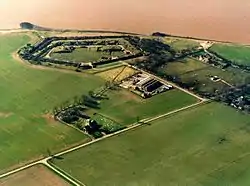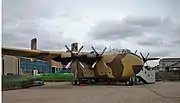Fort Paull
Fort Paull was a gun battery situated on the north bank of the Humber, near the village of Paull, downstream from Hull in northern England.
| Fort Paull | |
|---|---|
Paull Cliff Battery Point Cliff Battery[1] | |
 Aerial view | |
 Fort Paull Location within the East Riding | |
| Coordinates | 53.713360°N 0.229450°W |
| Type | Napoleonic War |
| Site history | |
| Built | 1861–1864 |
| In use | 1864–1960 |
| Garrison information | |
| Occupants | Fort Paull, Museum, Armouries and Visitors Centre |
History
Batteries have been built at Paull by Henry VIII, Charles I during the Civil War during the siege of Hull and the Napoleonic Wars. The first fort built on the site was started in 1542 with a capacity for 12 guns.[2] The current fort is of pentagonal design and was built in 1861–4 and on the recommendations of the Royal Commission, hence it is one of the Palmerston Forts.[3]
Armament
The original emplacements, nineteen 64-pounder (29 kg) RML artillery pieces were concealed or demolished in 1894 when concrete emplacements for three 6-inch Breech Loading (BL) guns on hydroneumatic carriages and two 4.7-inch Quick Firing (QF) guns were built. A mining station was added in 1886 and searchlights followed in 1907.[2] The three 6-inch gun positions were remodelled after 1902 to newer Mark VII types on central pivot mountings.
At the outset of the First World War, Paull was judged too close to Hull, so was disarmed when new forts were built at Sunk Island and Stallingborough.[4] The fort was used as a training base between the wars, and during the Second World War, it was converted into a magazine to serve the Russian convoys; a degaussing station was also added.[2]
Present day
In 1960, Fort Paull was released from the Ministry of Defence and closed down. In 1964, a group of volunteers, the Friends of Fort Paull took over the site and began to restore the fort as a heritage museum. Fort Paull finally opened to the public in 2000. Fort Paull houses a waxwork museum showing figures which have influenced the fort's long history as well as an armoury showing various artillery pieces and armoured vehicles. The fort also plays hosts to various military re-enactments from time to time.
Fort Paull is the location of the last remaining complete Blackburn Beverley heavy transport aircraft.[5]
In January 2020, it was announced that the attraction would not be opening for the 2020 season.[6]
The museum will come to a final end when the contents of Fort Paull are auctioned on 19 September 2020.[7] The contents auction raised a six-figure sum, the Blackburn Beverley bringing £21,000.[8]
Gallery
 The last Blackburn Beverley
The last Blackburn Beverley 3.7 inch anti-aircraft gun
3.7 inch anti-aircraft gun Entrance to Fort Paull
Entrance to Fort Paull
References
- Foster, Joe (2004). The Guns of the North-East. Barnsley: Pen & Sword. p. 164. ISBN 978-1-84415-088-5.
- Historic England. "Paull Point Battery, coastal artillery battery and Submarine Mining Establishment (1020425)". National Heritage List for England. Retrieved 13 January 2018.
- Simon, Jos (4 July 2014). "Yorkshires overlooked oddities". Rough Guides. Rough Guides. Retrieved 2 October 2016.
- "Fort Paull, East Yorkshire: Defending the Humber Estuary". BBC World War One at home. BBC. 6 November 2014. Retrieved 30 September 2016.
- "Fort Paull, East Riding". The Heritage Trail. Archived from the original on 13 December 2011. Retrieved 2 March 2011.
- "Fort Paull exhibit doubts after museum's sudden closure". BBC News. BBC. 21 January 2020. Retrieved 21 January 2020.
- "Fort Paull Auction". Gilbert Baitson. Retrieved 23 August 2020.
- "Fort Paull auction: Museum sale raises 'six-figure sum'". BBC News. BBC. 20 September 2020. Retrieved 21 September 2020.